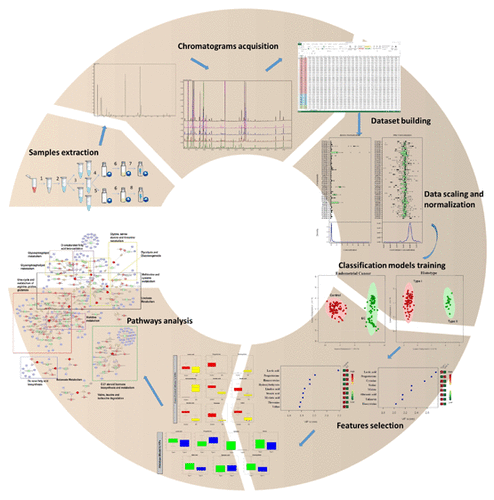当前位置:
X-MOL 学术
›
J. Proteome Res.
›
论文详情
Our official English website, www.x-mol.net, welcomes your
feedback! (Note: you will need to create a separate account there.)
Metabolomic Signature of Endometrial Cancer
Journal of Proteome Research ( IF 3.8 ) Pub Date : 2018-01-02 00:00:00 , DOI: 10.1021/acs.jproteome.7b00503 Jacopo Troisi 1, 2 , Laura Sarno 3 , Annamaria Landolfi 1 , Giovanni Scala 2 , Pasquale Martinelli 3 , Roberta Venturella 4 , Annalisa Di Cello 4 , Fulvio Zullo 4 , Maurizio Guida 1, 2
Journal of Proteome Research ( IF 3.8 ) Pub Date : 2018-01-02 00:00:00 , DOI: 10.1021/acs.jproteome.7b00503 Jacopo Troisi 1, 2 , Laura Sarno 3 , Annamaria Landolfi 1 , Giovanni Scala 2 , Pasquale Martinelli 3 , Roberta Venturella 4 , Annalisa Di Cello 4 , Fulvio Zullo 4 , Maurizio Guida 1, 2
Affiliation

|
Endometrial cancer (EC) is the most common cancer of the female reproductive tract in developed countries. At the moment, no effective screening system is available. Here, we evaluate the diagnostic performance of a serum metabolomic signature. Two enrollments were carried out, one consisting of 168 subjects: 88 with EC and 80 healthy women, was used for building the classification models. The second (used to establish the performance of the classification algorithm) was consisted of 120 subjects: 30 with EC, 30 with ovarian cancer, 10 with benign endometrial disease, and 50 healthy controls. Two ensemble models were built, one with all EC versus controls (Model I) and one in which EC patients were aggregated according to their histotype (Model II). Serum metabolomic analysis was conducted via gas chromatography–mass spectrometry, while classification was done by an ensemble learning machine. Accuracy ranged from 62% to 99% for the Model I and from 67% to 100% for the Model II. Ensemble model showed an accuracy of 100% both for Model I and II. The most important metabolites in class separation were lactic acid, progesterone, homocysteine, 3-hydroxybutyrate, linoleic acid, stearic acid, myristic acid, threonine, and valine. The serum metabolomics signature of endometrial cancer patients is peculiar because it differs from that of healthy controls and from that of benign endometrial disease and from other gynecological cancers (such as ovarian cancer).
中文翻译:

子宫内膜癌的代谢组学特征
子宫内膜癌(EC)是发达国家女性生殖道最常见的癌症。目前,没有有效的筛查系统。在这里,我们评估血清代谢组学特征的诊断性能。进行了两次入选,其中包括168位受试者:88位EC患者和80位健康女性,用于建立分类模型。第二个(用于建立分类算法的性能)由120位受试者组成:30位患有EC,30位患有卵巢癌,10位患有良性子宫内膜疾病以及50位健康对照。建立了两个集合模型,一个具有所有EC与对照的集合模型(模型I),一个集合了EC患者根据其组织类型进行汇总的模型(模型II)。血清代谢组学分析是通过气相色谱-质谱法进行的,而分类是由整体学习机完成的。型号I的准确度从62%到99%不等,型号II的准确度从67%到100%不等。集成模型对模型I和II的准确性均为100%。分类分离中最重要的代谢物是乳酸,孕酮,高半胱氨酸,3-羟基丁酸酯,亚油酸,硬脂酸,肉豆蔻酸,苏氨酸和缬氨酸。子宫内膜癌患者的血清代谢组学特征是独特的,因为它不同于健康对照,良性子宫内膜疾病和其他妇科癌症(例如卵巢癌)。分类分离中最重要的代谢物是乳酸,孕酮,高半胱氨酸,3-羟基丁酸酯,亚油酸,硬脂酸,肉豆蔻酸,苏氨酸和缬氨酸。子宫内膜癌患者的血清代谢组学特征是独特的,因为它与健康对照,良性子宫内膜疾病和其他妇科癌症(例如卵巢癌)不同。分类分离中最重要的代谢物是乳酸,孕酮,高半胱氨酸,3-羟基丁酸酯,亚油酸,硬脂酸,肉豆蔻酸,苏氨酸和缬氨酸。子宫内膜癌患者的血清代谢组学特征是独特的,因为它与健康对照,良性子宫内膜疾病和其他妇科癌症(例如卵巢癌)不同。
更新日期:2018-01-02
中文翻译:

子宫内膜癌的代谢组学特征
子宫内膜癌(EC)是发达国家女性生殖道最常见的癌症。目前,没有有效的筛查系统。在这里,我们评估血清代谢组学特征的诊断性能。进行了两次入选,其中包括168位受试者:88位EC患者和80位健康女性,用于建立分类模型。第二个(用于建立分类算法的性能)由120位受试者组成:30位患有EC,30位患有卵巢癌,10位患有良性子宫内膜疾病以及50位健康对照。建立了两个集合模型,一个具有所有EC与对照的集合模型(模型I),一个集合了EC患者根据其组织类型进行汇总的模型(模型II)。血清代谢组学分析是通过气相色谱-质谱法进行的,而分类是由整体学习机完成的。型号I的准确度从62%到99%不等,型号II的准确度从67%到100%不等。集成模型对模型I和II的准确性均为100%。分类分离中最重要的代谢物是乳酸,孕酮,高半胱氨酸,3-羟基丁酸酯,亚油酸,硬脂酸,肉豆蔻酸,苏氨酸和缬氨酸。子宫内膜癌患者的血清代谢组学特征是独特的,因为它不同于健康对照,良性子宫内膜疾病和其他妇科癌症(例如卵巢癌)。分类分离中最重要的代谢物是乳酸,孕酮,高半胱氨酸,3-羟基丁酸酯,亚油酸,硬脂酸,肉豆蔻酸,苏氨酸和缬氨酸。子宫内膜癌患者的血清代谢组学特征是独特的,因为它与健康对照,良性子宫内膜疾病和其他妇科癌症(例如卵巢癌)不同。分类分离中最重要的代谢物是乳酸,孕酮,高半胱氨酸,3-羟基丁酸酯,亚油酸,硬脂酸,肉豆蔻酸,苏氨酸和缬氨酸。子宫内膜癌患者的血清代谢组学特征是独特的,因为它与健康对照,良性子宫内膜疾病和其他妇科癌症(例如卵巢癌)不同。











































 京公网安备 11010802027423号
京公网安备 11010802027423号